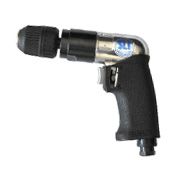Pneumatic drills
According to the suggestions of the Taiwanese manufacturer Sumake, whose pneumatic tools have been in our offer for two decades, pneumatic drills can be divided into two groups - industrial pneumatic drills and pneumatic workshop drills.
Both groups of tools include both high-speed and low-speed pneumatic drills with one or two directions of rotation and 6 mm, 10 mm and 13 mm drill holders.
Both groups have their supporters. It is important to consciously choose the tools for your production profile.
All pneumatic tools , driven by a medium such as compressed air, basically require the use of filters that will prepare them to a technically clean level. However, cleanliness is one thing and lubrication is another, so you will need a lubricator .
For this option, it is best to use a so-called compressed air station where filtering with oiling happens as if from an automatic machine. Of course, you can dose the oil manually each time, but as life says, you only remember this at the beginning, when the tool is new, and after a few times you "forget" because it's a waste of time. In addition, the spilled tool will stick the blades on the rotor and when the air used is dirty (unfiltered) it will catch dirt, and thus a power drop or blockage of the rotor is a matter of time.
A non-oiled tool will work inefficiently under all conditions, which is why a compressed air preparation system is so important. It is also part of the warranty maintenance. Not all users are aware that moisture and water droplets leave an irreversible mark on its surface. Post-fact lubrication and a possible defect in the drive may void our warranty rights.
Pneumatic drills can be equipped with a traditional handle, the so-called jaw with a key, as well as an automatic one. The latter is most often found in production conditions when the diameter of the drill needs to be changed quickly.
The handles in both versions are most often available in versions up to 10mm and 13mm and are available as a replaceable element, even in the process
When choosing a pneumatic drill, it is important to choose the type of tool that does not cause trouble and the tool itself is neither too weak nor too strong.
For brittle material, such as brass, it should be a high-speed drill, and for eg aluminum it should be slower. A correctly selected tool ensures the safety of the working person and the material being processed. An approach that is still deeply entrenched in the industry that the tool will go for "everything" and nothing will happen must absolutely be avoided.
Proper selection of the tool means satisfaction, security and efficiency. These are the key keywords that will help us assess our needs and expectations related to the purchase.
Drills for which we are "cared for" during the warranty period and after the termination of such rights, along with diagnostics, repair, or purchase of parts, makes the tool durable for years.
Industrial pneumatic drills
Industrial pneumatic drills are tools that, due to their properties, are intended for continuous work in heavy industrial conditions. Their common feature is a specially patented air motor, the output of which is up to 30% greater than that of traditional drills. Great emphasis was also placed on ergonomics and work comfort.
The special design (including a reduced number of internal components) of these tools and the housing material used in them (depending on the model: either a composite or a special aluminum alloy) allowed to significantly reduce the weight of the drills from this series. Even the largest models weigh less than 1 kg here. What's more, the offered pneumatic drills are perfectly balanced and have a reduced level of vibration, thanks to which the operator can comfortably use the device even for a longer period of time.
Particularly noteworthy in the group of industrial drills that we offer are the models from the ADDN series , which have as many as three differently arranged air connections, which increases flexibility and the possibility of installation on production lines.
Often, which is not always known or remembered, you can use SUMAKE balancers from our offer, which, after selecting the appropriate weight of the tool, will contribute to relieving the employee's arm while increasing comfort at the workplace. Besides ... the tool itself is always at hand without the risk of falling, damaging or breaking the drill bit.
Pneumatic workshop drills
Workshop drills are tools that are an ideal solution for small companies and workshops, for even hobby use, where they are used sporadically and occasionally with the principle - for looser work, not in production.
Contrary to what it might seem, pneumatic workshop drills are also solid, durable and reliable tools, which, due to their increased weight, are not recommended for continuous and multi-shift work.
Compared to technologically advanced models from the industrial series, where light metal alloys and composites were used, they will be distinguished by a more attractive price and availability on the market. As a result, such tools are offered both in large chains and in many sellers as basic ones. And the only differences can be in the workmanship, equipment or, ultimately, durability.



Login and Registration Form